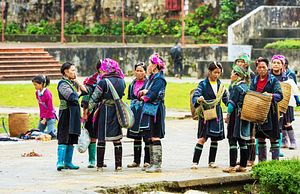The Vietnamese frontier town of Sa Pa sits 1,600 meters above sea level in the mighty shadow of Fansipan, Indochina’s highest mountain. Surrounded on all sides by a stunning backdrop of stacked rice terraces, the town’s only link to the outside world is by steep and winding roads that are dangerously narrow in parts.
And yet, every day the early morning mist lifts in Sa Pa to reveal streets lined with fancy hotels, Western restaurants, clothes shops, and ATMs. In the faded buildings where tired local traders and French missionaries would once stop for refreshment, backpackers now gather for Happy Hour. Welcome to Sa Pa – tourist heartland.
At the center of this rather lucrative industry are vibrantly dressed members of the area’s six main ethnic groups, who gather in huge numbers in the town to sell local souvenirs, organize rural treks, and drum up business for their homestays. The most surprising part? There is rarely a man in sight.
Bam Dzam, 29, is from the Black Hmong group – so called because of their traditional black embroidered outfits, dyed using indigo plants. For the last eight years, she has worked as a tour guide, a very different path from any she could have imagined as a child.
“My parents made me leave school when I was 15 to get married. I went to live with my husband and we had three daughters who I raised while working on our rice farm. I started selling handicrafts when lots of tourists began coming about ten years ago, before deciding to be a guide instead.”
Although Hmong women now account for about 80 percent of Sa Pa’s tour guides, at the time Bam’s decision was met with disapproval by the men in her community. “They told my husband that he shouldn’t let me do the job, because I would fall in love with a foreigner with lots of money and run away.”
The issue of women’s rights is a complex one in Vietnam. While the Government has introduced several strong laws on gender equality and the UN has hailed its progress in meeting its Millennium Development Goal to empower women, inequality remains widespread in what is a firmly patriarchal society.
A 2011 gender assessment published by the World Bank found that in Vietnam, “women earn less than men when holding the same positions and continue to do most of the unpaid housework.”
Meanwhile, a cultural preference for sons – one old Vietnamese saying translates as “If you have a son, you can say you have a descendant, but you can’t say this even if you have 10 daughters” – has led to a rise in abortions, creating a worrying national gender ratio of 100 girls for every 112 boys.
The problems are particularly evident in mountainous regions where the poverty rate is three times the national average and women struggle to access healthcare, education, and economic opportunities.
In Sa Pa, though, things are changing, according to the head of the Lao Cai Province Department of Culture, Sport and Tourism, Dr. Tran Huu Son. “Tourism has been good here. It is creating many jobs and opportunities for women.”
Bam certainly seems to be enthusiastic about her job. During her tours she chats eagerly about her life and home – a cascade of conversation in near-perfect English, punctuated by bursts of infectious laughter – and shows off her general knowledge. “You’re from the north of England” she remarks to one Teesside couple as she helps them clamber up onto a narrow rice terrace, “that’s near Scotland, right?”
“I was always interested talking to foreigners,” she later explains. “I never learnt English at school, but I knew it was important. When I started my job I spoke about 50 words and I couldn’t explain anything, so I had to learn through conversation.”
Her language skills, in addition to her flair for organization, and a relationship with a local travel agency mean that Bam has many customers and her monthly income (around $250), while still low by national standards, far surpasses anything she could have earned before. These earnings have been used to build a smart new house for her family and buy a motorbike for her husband.
“The financial balance is changing,” reveals Son. “The fact is that now many Sa Pa women are earning more than the men and this is giving them a much stronger voice in local decision making.”
“The village men respect me more now for my success,” Bam admits, “and in fact many of their wives now do the same job.”
In response to this growing workforce in the tourism sector, the local government is determined to ensure women have the skills to thrive. Son’s department is offering training courses in tourism, families are being fined for pulling their children out of school, and financial rewards have been introduced to encourage further education.
This policy has brightened the future prospects for Bam’s daughters, who are already enjoying an education that Bam was deprived of. “I am happy I can afford to pay the school fees for my girls and I will make sure that they finish. I dream of them going to university.”
Bam’s husband agrees, which itself suggests that Hmong family dynamics are changing. Together, Bam and her husband have decided not to try for a son and not to force their daughters into arranged marriages.
Meanwhile, development in Sa Pa continues at a rapid pace. With a new highway planned and construction underway on a cable car to the summit of Mount Fansipan, tourists are expected in even greater numbers. The independent women of Sa Pa are ready to welcome them.
Kim Megson is a freelance writer based in Hanoi.


































